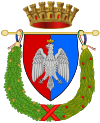Mentana
| Mentana | ||
|---|---|---|
| Comune | ||
| Comune di Mentana | ||
|
| ||
| ||
 Mentana Location of Mentana in Italy | ||
| Coordinates: 42°01′N 12°39′E / 42.017°N 12.650°E | ||
| Country | Italy | |
| Region | Latium | |
| Metropolitan city | Rome (RM) | |
| Frazioni | Casali, Castelchiodato, Mezzaluna | |
| Government | ||
| • Mayor | Marco Benedetti | |
| Area | ||
| • Total | 24.27 km2 (9.37 sq mi) | |
| Elevation | 150 m (490 ft) | |
| Population (31 October 2017) | ||
| • Total | 23,143 | |
| • Density | 950/km2 (2,500/sq mi) | |
| Demonym(s) | Mentanesi | |
| Time zone | UTC+1 (CET) | |
| • Summer (DST) | UTC+2 (CEST) | |
| Postal code | 00013 | |
| Dialing code | 06 | |
| Patron saint | St. Nicholas of Bari | |
| Saint day | December 6 | |
| Website | Official website | |
Mentana is a town and comune, former bishopric and present Latin Catholic titular see in the Metropolitan City of Rome, Lazio, central Italy. It is located 29 kilometres (18 mi) north-east of Rome and has a population of about 23,000.
History
Mentana's name in ancient times was Nomentum, to which the Via Nomentana led from Rome.[1] According to Livy, the town was part of the Latin League, which went to war with Rome during the reign of Rome's king Lucius Tarquinius Priscus. Nomentum was one of a number of towns captured by Tarquinius.[2]
It was a Latin town, but was considered by some to be Sabine, and, like Fidenae and Ficulea, was excluded from the first region by Augustus, who made the Anio river its northern boundary. The city was part of the League defeated by Rome in the Battle of Lake Regillus, and was captured definitively in 338 BCE.
Subsequently, Nomentum received the civitas sine suffragio; in its municipal constitution the chief magistrate even in imperial times bore the title of dictator. Pliny and Martial often praise the fertility of its neighbourhood.
In 741 it was briefly occupied by the Lombards and the inhabitants moved to a new centre on the Via Nomentana which was more easily defendable. On 23 November 799, it was the site of the meeting of Pope Leo III and Charlemagne.
The Castle of Nomentum was a possession of the Roman family of the Crescenzi in the 10th and 11th century. In 1058 it was destroyed by the Normans and the population was drastically reduced. The castle was acquired by the Capocci family and, later, the Holy See entrusted it to the Benedictine monks of San Paolo fuori le Mura.
In the 15th century it was under control of the Orsini family. In 1484 it was damaged by an earthquake. In 1594 it became a fief of the Perett family, first under Michele Perett of Venafro, and then in 1655 it came under the control of Marcantonio Borghese and the House of Borghese.
On 3 November 1867 the city was the site of the Battle of Mentana between French-Papal troops and the Italian volunteers led by Giuseppe Garibaldi, who were attempting to capture Rome in order to incorporate it into the newly unified Kingdom of Italy. The battle ended in a victory by the French-Papal troops. In Mentana, the monument Ara dei Caduti (Altar of the Fallen) is built over the mass grave of the Italian patriots who died in the battle.
Ecclesiastical History
In 408 CE Nomento is mentioned as an episcopal see (established circa 40 AD), and in February 593 it gained the territory of the suppressed annexed the Roman Catholic Diocese of Passo Curese (Cures (Sabinorum), Curi).
(No residential incumbent names available)
In May 944 it was suppressed, its territory being merged into the Roman Catholic Diocese of Vescovìo.
Titular see
The diocese was nominally restored as a Latin Catholic titular bishopric in 1966.
It has had the following incumbents, of the lowest (episcopal) and once archiepiscopal (intermediary) ranks :
- Emanuele Gerada (1967.02.15 – 1973.11.08)
- Titular Archbishop Emanuele Gerada (1973.11.08 – 2011.01.21)
- Habib Chamieh, Mariamite Maronite Order (O.M.M., Aleppians) (2013.04.17 – ...), Apostolic Administrator of San Charbel en Buenos Aires of the Maronites (Argentina).
Main sights
- The Castle (c. 1000), housing the Archaeological Museum and is a site of art exhibitions.
- Palazzo Crescenzio
- Funerary Monument of the Appulei, a 2nd-century BC travertine frieze
- Museum of the Risorgimento
- Science Museum.
- The Nature Preserve of Nomentum includes the Trentani Park and the Macchia (Maquis shrubland) of Gattacieca, the remains of the ancient city as well as a necropolis of the 8th century BCE.
References
- ↑ Corrado Pala; Unione Accademica Nazionale (1976). Forma Italiae: Latium et Campania. Nomentum. De Luca Ed.
- ↑ Livy, Ab urbe condita, 1:38
Source and External links
| Wikimedia Commons has media related to Mentana. |

